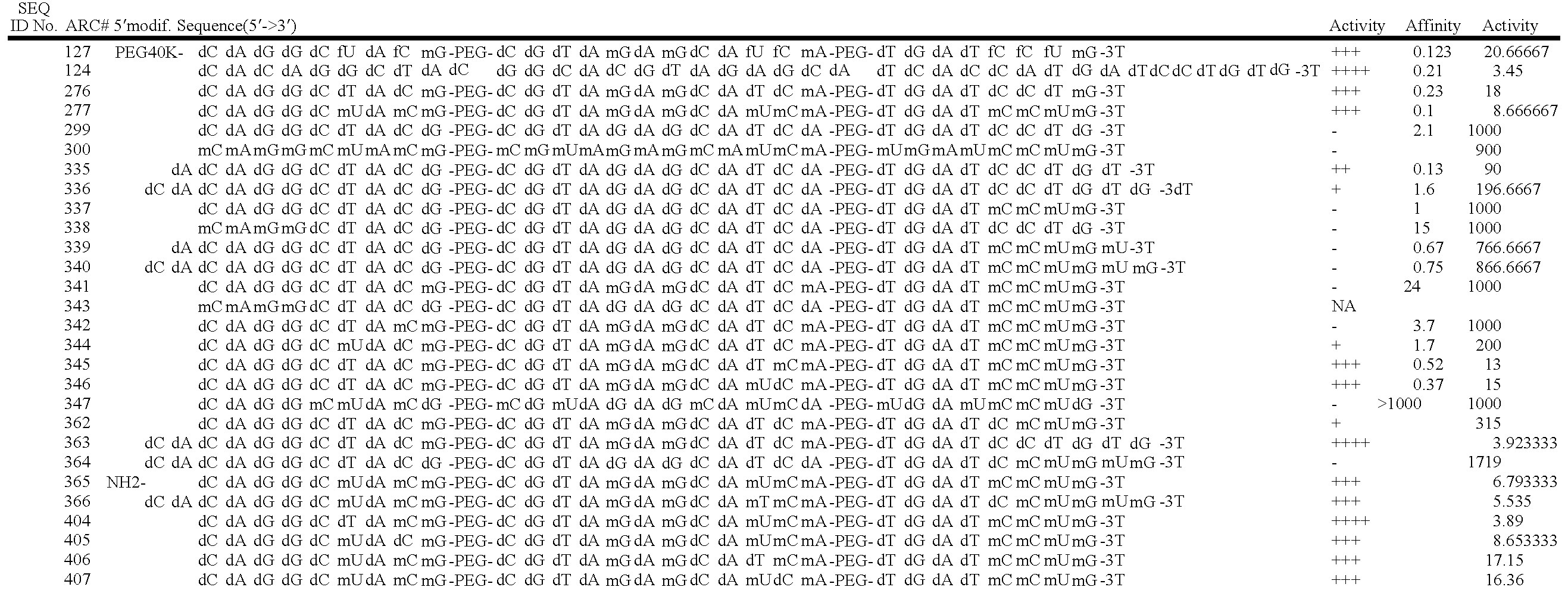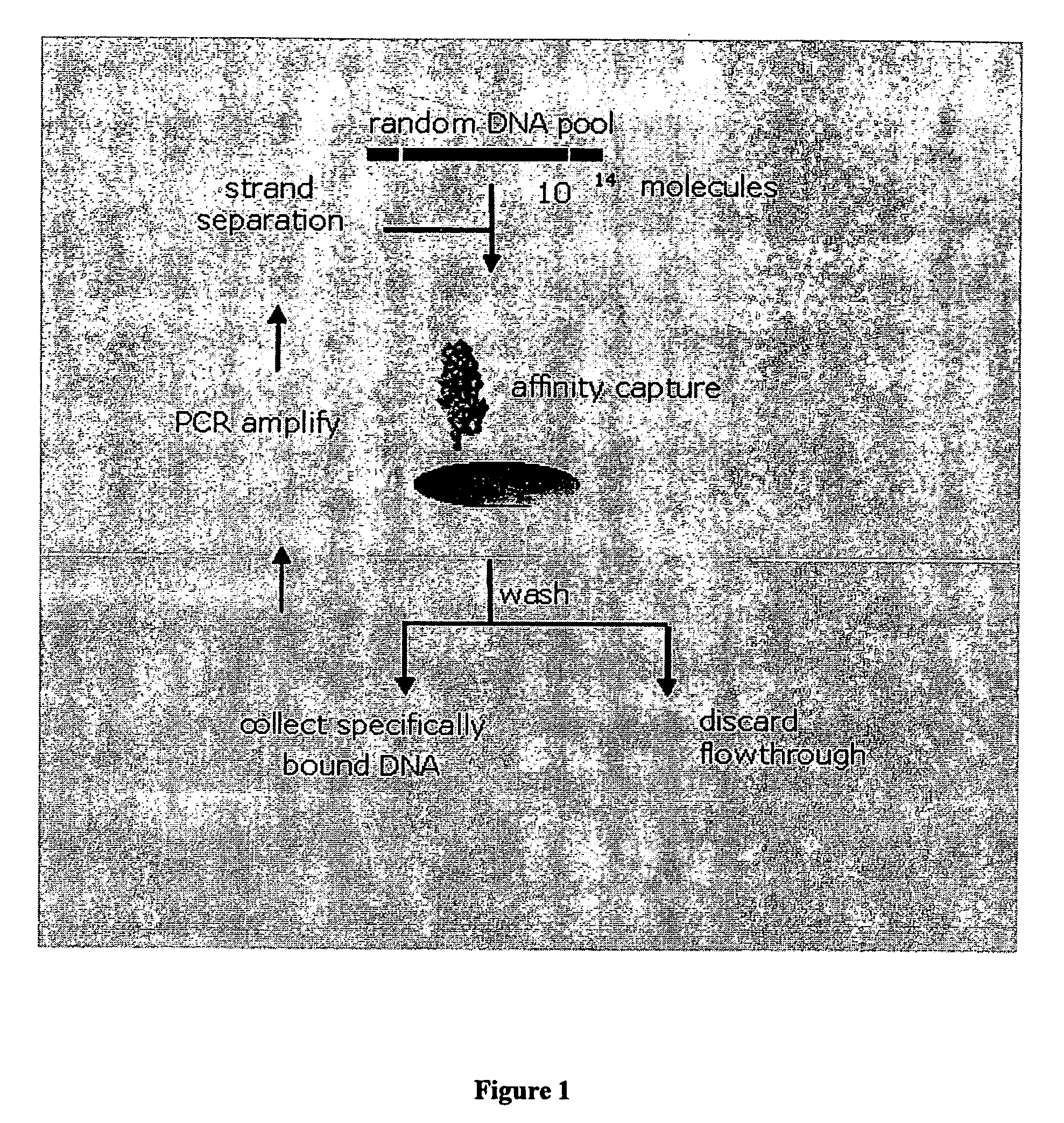Stabilized aptamers to platelet derived growth factor and their use as oncology therapeutics
a technology of platelet derived growth factor and stabilized aptamers, which is applied in the field of nucleic acids, can solve the problems of limiting the availability of some biologics, scalability and cost, and extremely difficult to elicit antibodies to aptamers
- Summary
- Abstract
- Description
- Claims
- Application Information
AI Technical Summary
Benefits of technology
Problems solved by technology
Method used
Image
Examples
example 1
Large Scale Aptamer Synthesis and Conjugation
[0249] ARC126 (5′-(SEQ ID NO:1)-HEG-(SEQ ID NO:2)-HEG-(SEQ ID NO:3)-3′ dT-3′) is a 29 nucleotide aptamer (excluding an inverted T at the 3′ end) specific for PDGF which contains a 3′ inverted-dT cap for enhanced stability against nuclease attack. PEG moieties can be conjugated to ARC126 by using a 5′-amino terminus modifier for subsequent conjugation reactions. Syntheses were performed using standard solid-phase phosphoramidite chemistry. The oligonucleotide was deprotected with ammonium hydroxide / methylamine (1:1) at room temperature for 12 hours and purified by ion exchange HPLC. ARC 128 (5′-(SEQ ID No.4)-HEG-(SEQ ID NO:5)-HEG-(SEQ ID NO:6)-3′), an inactive variant which no longer binds PDGF, was synthesized using the same method.
[0250] ARC126 was conjugated to several different PEG moieties: 20 kDa PEG (ARC240, (5′-[20K PEG]-(SEQ ID NO:1)-HEG-(SEQ ID NO:2)-HEG-(SEQ ID NO:3)-3′ dT-3′)); 30 kDa PEG (ARC308, (5′-[30K PEG]-(SEQ ID NO:1)-...
example 2
Stability Studies with Fluorinated Aptamers
[0253] ARC126 and ARC127 freshly synthesized in house were compared to ARC126 and ARC127 that were synthesized by Proligo (Boulder, Colo.), and had been stored lyophilized for 2 years at −20° C. (legacy aptamers).
[0254] ARC127 synthesized in house and legacy ARC 127 were passed over an ion-exchange HPLC column for analysis. FIG. 5A is a trace of an ion-exchange HPLC analysis of freshly synthesized and legacy ARC 127 showing that after 2 years storage lyophilized at −20° C., relatively no degradation of the legacy ARC127 was detected.
[0255] The legacy ARC 126 and ARC127 aptamers stored at −20° C. for two years were also tested for potency, and compared to freshly synthesized ARC126 and ARC127 synthesized in house using the 3T3 cell proliferation assay (Example 3). FIG. 5B shows cell-based assay results for potency demonstrating that even after lyophilization and storage at −20 degrees for 2 years, the legacy aptamers were just as potent a...
example 3
Composition and Sequence Optimization of ARC126 Variants
[0256] The sequence and secondary structure of the anti-PDGF aptamer designated ARC126 is shown in FIG. 6A. The sequence and secondary structure of derivatives of ARC 126 in which the nucleotides with 2′-fluoro-substituents have been replaced are shown in FIG. 6B. The loops shown at the termini of the two internal stems are polyethylene glycol-6 (PEG-6) spacers and modified nucleotides are represented by dA=deoxyadenosine; dG=deoxyguanosine; mA=2′-O-methyladenosine; dT=deoxythymidine; dC=deoxycytosine; mT=2′-O-methylthymidine; mG=2′-O-methylguanosine; mC=2′-O-methylcytosine; [3′T]=inverted deoxythymidine; fC=2′-fluorocytosine; and fU=2′-fluorouridine.
[0257] As shown in FIG. 6A, the 29-nucleotide composition of ARC126 contains seven 2′-fluoro residues (three 2′-fluorouridines and four 2′-fluorocytosines). Due to considerations including genotoxicity of breakdown products, the compositional optimization of ARC126 with the goal ...
PUM
| Property | Measurement | Unit |
|---|---|---|
| molecular weight | aaaaa | aaaaa |
| solubility | aaaaa | aaaaa |
| volume | aaaaa | aaaaa |
Abstract
Description
Claims
Application Information
 Login to View More
Login to View More - R&D
- Intellectual Property
- Life Sciences
- Materials
- Tech Scout
- Unparalleled Data Quality
- Higher Quality Content
- 60% Fewer Hallucinations
Browse by: Latest US Patents, China's latest patents, Technical Efficacy Thesaurus, Application Domain, Technology Topic, Popular Technical Reports.
© 2025 PatSnap. All rights reserved.Legal|Privacy policy|Modern Slavery Act Transparency Statement|Sitemap|About US| Contact US: help@patsnap.com



